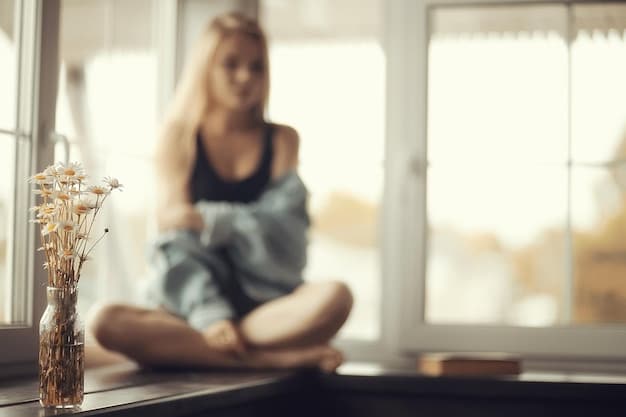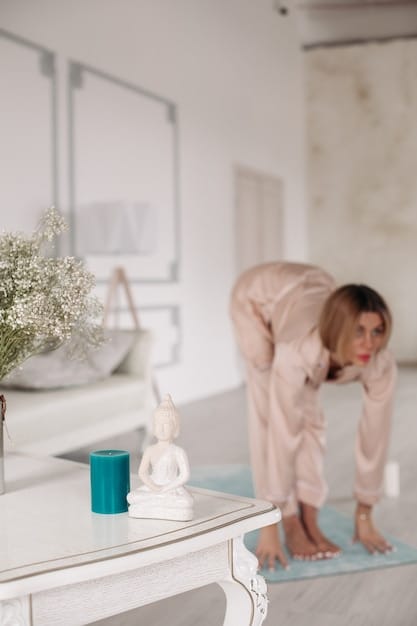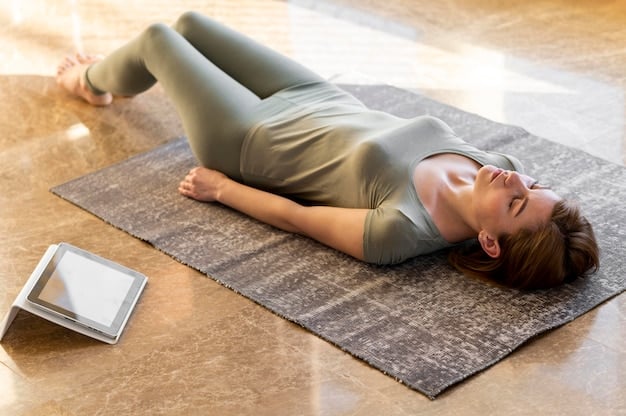Yoga for Stress Relief: Simple Poses You Can Do at Home

Yoga for stress relief offers a natural way to calm the mind and body through accessible poses you can easily practice at home, promoting relaxation and reducing anxiety.
Feeling overwhelmed? Discover how practicing yoga for stress relief can transform your well-being with these simple and effective poses you can do right at home.
The Power of Yoga for Stress Reduction
In today’s fast-paced world, stress has become an all-too-common companion. Fortunately, there are effective ways to manage and mitigate its effects. Yoga, an ancient practice with roots in India, has emerged as a powerful tool for stress reduction. It combines physical postures, breathing techniques, and meditation to promote relaxation, mental clarity, and overall well-being.
Yoga can be a wonderful way to feel more grounded and peaceful. It offers more than just a physical workout; it’s a holistic approach to health that addresses the mind-body connection, making it an ideal solution for those seeking natural stress relief.
Why Yoga Works for Stress
Yoga’s effectiveness in stress reduction lies in its ability to regulate the nervous system and calm the mind. Here are some reasons this practice is so effective:
- Reduces Cortisol Levels: Studies have demonstrated that regular yoga practice can lower cortisol, also known as the stress hormone, in the body.
- Increases GABA Levels: Yoga has been shown to increase levels of gamma-aminobutyric acid (GABA), a neurotransmitter that helps to regulate nerve impulses and promote relaxation.
- Promotes Mindfulness: Yoga encourages practitioners to focus on the present moment, which can help to reduce worrying and anxiety about the future or rumination on the past.
- Enhances Body Awareness: Through physical postures and breathwork, yoga cultivates a deeper awareness of the body, allowing individuals to recognize and respond to physical tension and discomfort associated with stress.
Ultimately, the calming effects on the body and nervous system also calm the mind, allowing you to feel more balanced and relaxed.
Creating Your Home Yoga Sanctuary
One of the greatest advantages of yoga is its accessibility. You don’t need fancy equipment or a studio membership to reap its benefits; you can practice yoga in the comfort of your own home. Creating a dedicated space for your practice can further enhance its effectiveness.
Setting the stage for your home yoga practice can be as simple or elaborate as you like. The goal is to create an environment that feels safe, comfortable, and conducive to relaxation.

Tips for Setting Up Your Yoga Space
The best approach to creating your home yoga sanctuary will depend on your living space, budget, and personal preferences. The main thing is to ensure the area feels relaxing and inviting to you.
- Choose a Quiet Space: Select a room or corner of your home where you can practice without interruptions.
- Declutter: Remove any unnecessary items that may distract you or impede your movement.
- Adjust Lighting: Soft, natural light is ideal, but if that’s not available, opt for dim lighting or candles to create a relaxing ambiance.
- Add Greenery: Incorporate plants or flowers to bring a sense of nature and freshness into your space.
By investing a little time and effort into creating a serene and inviting space, you can transform your home into a personal yoga sanctuary where you can escape the stresses of daily life and reconnect with yourself.
Essential Yoga Poses for Stress Relief
Now that you have your space set up, it’s time to explore some essential yoga poses that are particularly effective for stress relief. These poses are gentle, accessible, and can be easily modified to suit your individual needs and abilities.
The great thing about these poses is that you don’t need any prior experience; they are designed for all levels.
Child’s Pose (Balasana)
Child’s Pose is a deeply restorative posture that gently stretches the lower back, hips, and ankles while promoting relaxation and calmness. It is also considered a gentle inversion. Here’s how to do it:
- Start on your hands and knees.
- Bring your big toes together and sit back on your heels.
- Separate your knees slightly apart and fold forward, resting your forehead on the mat.
- Extend your arms forward, palms facing down, or rest them alongside your body, palms facing up.
- Relax your shoulders and breathe deeply, allowing your body to sink into the pose.
Hold for 5-10 breaths, focusing on releasing tension with each exhale.
Seated Forward Bend (Paschimottanasana)
Seated Forward Bend is a calming pose that stretches the spine, hamstrings, and lower back, promoting relaxation and reducing anxiety. The forward fold calms the nervous system, encouraging relaxation.
- Sit on the floor with your legs extended straight out in front of you.
- Inhale and lengthen your spine, reaching your arms overhead.
- Exhale and fold forward from your hips, reaching your hands towards your feet.
- If you can’t reach your feet, grab your ankles, shins, or thighs.
- Relax your head and neck and breathe deeply, allowing your body to fold further with each exhale.
Hold for 5-10 breaths, focusing on releasing tension in your spine and hamstrings. If this pose is difficult, you can bend your knees slightly.
Breathwork and Meditation for Enhanced Stress Reduction
Yoga is about more than just poses, though. You can also incorporate these potent techniques into your home practice for even greater stress relief. Breathwork and meditation can be easily integrated into your yoga routine, amplifying its stress-reducing effects and fostering a deeper sense of inner peace.
These calming practices only take a few minutes to incorporate into your workout.
- Diaphragmatic Breathing: This technique involves breathing deeply from the diaphragm, which helps to calm the nervous system and reduce feelings of anxiety. Place one hand on your chest and the other on your belly. Inhale deeply through your nose, allowing your belly to rise while keeping your chest relatively still. Exhale slowly through your mouth, contracting your belly muscles.
- Alternate Nostril Breathing (Nadi Shodhana): This breathing technique helps to balance the left and right hemispheres of the brain, promoting mental clarity and relaxation. Close your right nostril with your thumb and inhale deeply through your left nostril. Then, close your left nostril with your ring finger and exhale through your right nostril. Continue alternating nostrils with each breath.
Start with just a few minutes of these practices and gradually increase the duration as you become more comfortable. If you feel discomfort at any time, stop the exercises.
Modifying Poses for Your Needs and Abilities
Yoga is a highly adaptable practice, and it’s essential to modify poses to suit your individual needs and abilities, especially when dealing with stress or physical limitations. Listen to your body and honor its limitations, making adjustments as needed to ensure a safe and comfortable practice.
Never force your body into a position that feels painful or uncomfortable. Yoga is about gentle progress, not pushing yourself to the limit.
Tips for Modifying Yoga Poses
When modifying poses, it’s important to prioritize safety and comfort. Here are some basic rules to follow when adapting a pose:
- Use Props: Utilize props such as yoga blocks, blankets, or straps to support your body and modify poses as needed. Place a block under your hands in seated forward bend or under your hips in seated postures to make them more accessible.
- Listen to Your Body: Pay attention to any sensations or discomfort you may experience during practice. If a pose feels too strenuous or painful, modify it until it feels more comfortable.
- Practice with Awareness: Be mindful of your alignment and posture in each pose, making adjustments as needed to maintain proper form and prevent injury. Visualize the correct alignment and engage your muscles appropriately.
- Consult with a Teacher: If you’re unsure about how to modify a particular pose, seek guidance from a qualified yoga teacher. They can provide personalized instruction and support to help you adapt the practice to your individual needs.
These tips will ensure your safety and comfort so you can experience the poses with the most benefit.
Consistency and Patience: The Keys to Long-Term Stress Relief
While yoga can provide immediate relief from stress, its long-term benefits are best realized through consistent practice and patience. Remember that stress management is an ongoing process, and yoga is a valuable tool for cultivating resilience, mindfulness, and overall well-being.
It takes time to develop both physical and mental resilience. Stay patient and consistent in your own practice, and you’ll reap the benefits over time.
- Set Realistic Goals: Start with a manageable goal, such as practicing yoga for 15-20 minutes a few times a week, and gradually increase the duration and frequency as you feel more comfortable.
- Find Accountability: Enlist a friend or family member to practice yoga with you, or join a local studio or online community for support and encouragement.
- Celebrate Progress: Acknowledge and celebrate your progress along the way, no matter how small. Recognize the positive changes you’re experiencing in your mind, body, and overall well-being.
The key takeaway is that managing stress is a long game. Yoga is a powerful tool, but it requires time and consistency to build resilience and enjoy life to the fullest.

Conclusion
Incorporating yoga into your daily routine can be a fantastic way to manage stress and promote overall well-being. By creating a serene practice space at home, mastering essential poses, and practicing consistent breathwork, you can start to experience the transformative effects of yoga on your mind and body. So, roll out your mat, take a deep breath, and embark on your journey to a calmer, more centered you.
| Key Point | Brief Description |
|---|---|
| 🧘 Calming Poses | Yoga poses such as Child’s Pose and Seated Forward Bend promote relaxation and reduce tension. |
| 🌬️ Breathwork | Techniques like diaphragmatic and alternate nostril breathing help calm the nervous system. |
| 🏠 Home Sanctuary | Creating a dedicated, peaceful space at home enhances the yoga practice experience. |
| ⏱️ Consistency | Regular practice is essential for long-term stress relief and overall well-being. |
FAQ
▼
Child’s Pose, seated forward bend, and legs-up-the-wall pose are excellent for quick stress relief. They gently calm the nervous system and promote relaxation in both the body and mind.
▼
Aim for at least three times a week for 20-30 minutes each session to experience consistent stress reduction benefits. However, even short sessions daily can make a significant difference.
▼
Yes, yoga can be an effective complementary therapy for managing symptoms of anxiety and depression. It encourages relaxation, reduces cortisol levels, and promotes overall mental well-being through breath, movement and mental engagement.
▼
No, you don’t need much to get started with yoga at home. A yoga mat is helpful but not essential; a soft towel or carpeted area will also work. Optional props like blocks or straps can enhance your practice.
▼
Set realistic goals, create a specific time in your schedule, find an online community for support, and reward yourself for reaching milestones. Make it a ritual you look forward to!
Conclusion
Integrating yoga into your daily life provides a powerful tool for stress management and overall well-being. Embrace this practice, personalize it to suit your needs, and reap the rewards of a calmer, more centered life.





